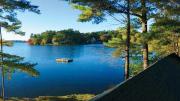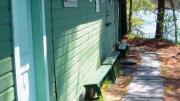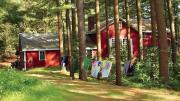Public baths are an ancient tradition. Turks have the hammam, Russians have banyas, and Japanese, their onsen. For Finns and Swedes, it’s the sauna: people happily clustered in a closed room heated to a toasty 220 degrees.
For devotees, it's a ritual, a spiritual and bodily cleansing, says David Straus, a regular at the region’s only traditional Finnish sauna, which has been run in rural Pembroke, Massachusetts, by the Uljas Koitto Temperance Society (UKTS) since 1927. For others, like Straus and his wife, Irina, from Latvia, who come weekly with their three young children, the experience is simply and deeply relaxing. “You sweat out all the impurities of the work week, you open and shut your pores; it just feels good,” he says. “We spend the whole day together. And you disconnect from the rest of the world.”
The property sits at the end of Suomi (“Finnish”) Road, a dirt drive leading into a pine-tree glade. There are two wood-fired saunas, one for each gender; both have attached rooms for changing and showering. Once hot enough, sauna-takers leave the cedar-paneled sweat dens, walk 10 feet, and dive into Furnace Pond. In the winter, a hole is cut into the ice for dunking. There’s also a lodge, built around 1900, where coffee, tea, and snacks, are served on a screened porch.
UKTS is run by a core group of about 45 volunteers who have cared enough over the years to keep it alive. A good number are descended from Finnish immigrants who first arrived in Quincy in the 1880s to work in the quarries; by 1920, that community had grown to more than 1,000 people, enough to support saunas, churches, and social clubs. The Uljas Koitto (“Noble Endeavor”) was a religious group founded in 1892 to stem drunkenness among fellow Finns—and liquor is still prohibited on the property.
Newcomers are warmly welcomed—and given tips: eat a solid meal about 90 minutes before entering the heat, drink lots of water, and take it slowly. The temperature changes can be a shock, literally.
Guests should bring toiletries, a water bottle, and towels along with a bathing suit, although many people choose to go nude in the sauna itself. The place draws a mix of long-term South Shore-dwellers and more recent immigrants, mainly from Europe; everyone tends to sit outside on benches and talk in between sweats and swims. Guests can also gather in the lodge’s living room, which has a fireplace, books, and toys.
It’s not a spa or a nudist colony, although it’s been mistaken for both. People seem to love it, or leave it. Straus has had friends visit “and never come back,” he says, laughing. “They can’t get used to so many people sitting in a small room barely clothed, or it’s just too hot.”
It’s also not a place to be loud or flashy, take selfies, blab on smart phones, or commune with laptops. People mostly sit quietly, and enjoy the natural setting. “You can go in and out of the sauna, you rest in between, out in the open air,” adds Straus, also the society’s treasurer. “You can take the kayak out. You eat, you swim, you meet people. People just enjoy talking to each other. It’s just so unique.”












